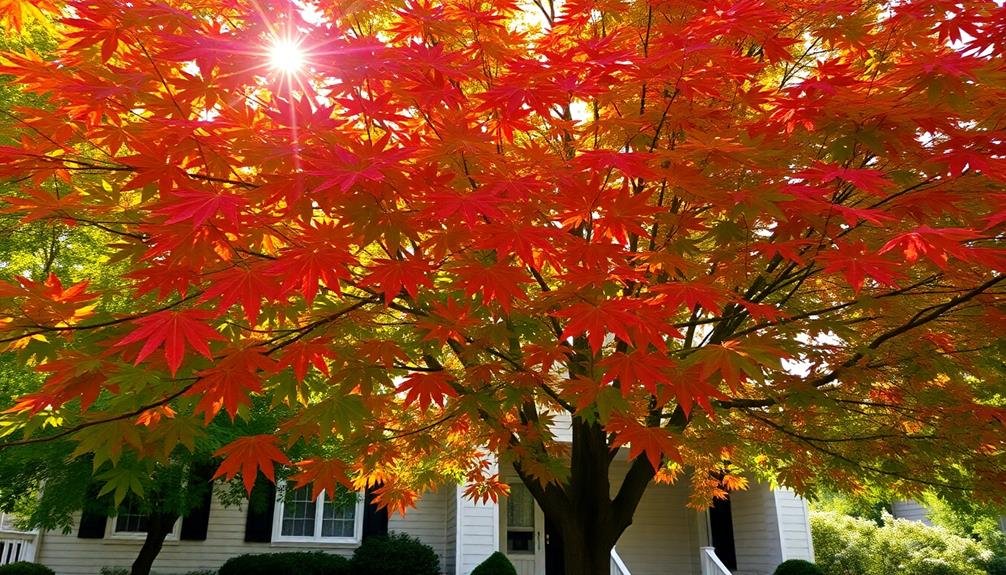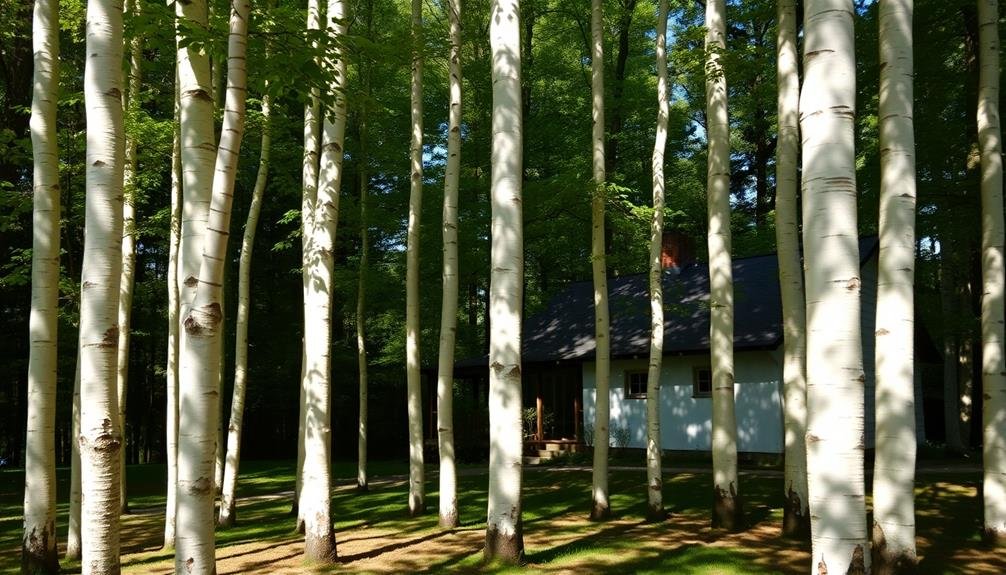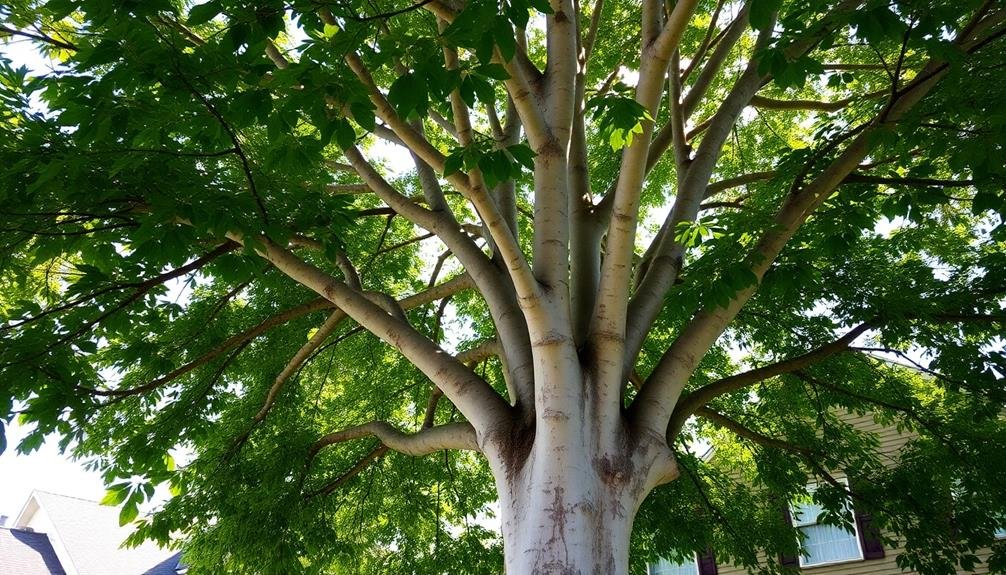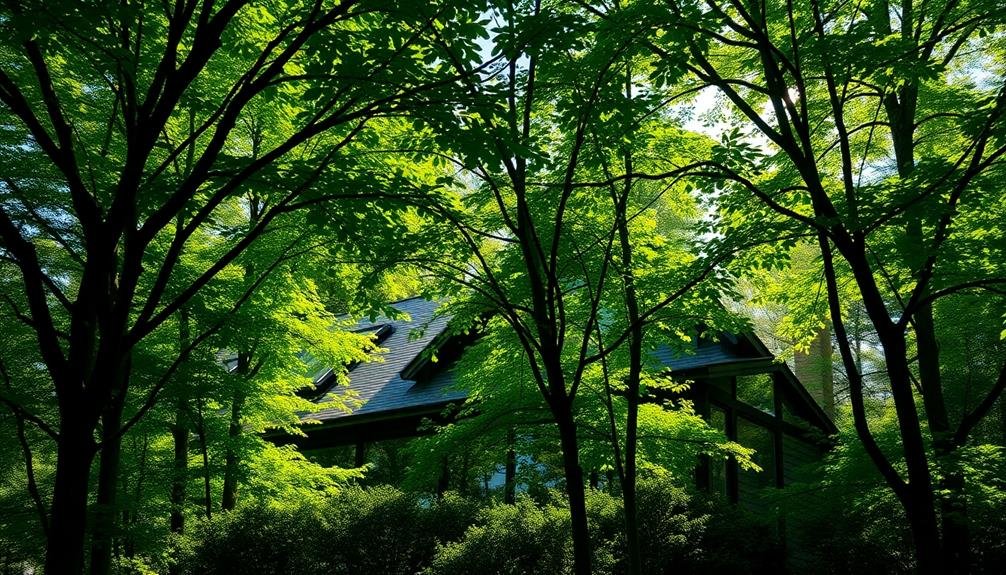You can greatly reduce your home's energy consumption and costs by strategically planting leafy trees around your property. Maple, oak, birch, beech, elm, sycamore, ash, poplar, and hickory trees are excellent choices for natural energy management. These trees provide ample shade during summer, reducing cooling needs, while allowing sunlight through in winter for natural warmth. They act as windbreaks, lowering heating costs, and improve air quality by absorbing CO2. Fast-growing varieties like birch and poplar offer quick results. With proper placement and care, these leafy giants can transform your home's energy efficiency. Discover how each tree species uniquely contributes to a more sustainable living environment.
Maple Trees

Majestic and versatile, maple trees offer excellent energy management benefits for homeowners. You'll find that these deciduous trees provide natural shade during hot summer months, effectively reducing your cooling costs. Their broad, dense canopies can block up to 95% of the sun's rays, keeping your home cooler and more comfortable.
In winter, maple trees shed their leaves, allowing sunlight to warm your home naturally. This cycle helps you save on both cooling and heating expenses throughout the year. You'll appreciate how maple trees can lower your energy bills by up to 25% when properly placed around your property.
Maple trees also act as windbreaks, reducing cold air infiltration during winter. By planting them on the north and northwest sides of your home, you'll create a barrier against chilly winds. This strategic placement can decrease your heating needs by up to 30%.
Additionally, maple trees contribute to improved air quality by absorbing carbon dioxide and releasing oxygen. You'll benefit from cleaner air while simultaneously reducing your carbon footprint.
With their stunning fall foliage and potential for maple syrup production, these trees offer both aesthetic and practical advantages for your home's energy management.
Oak Trees
Oak trees offer excellent shade and cooling benefits for your home, potentially reducing air conditioning costs during hot summer months.
You'll find various oak species suitable for different climates, from the heat-tolerant Southern Live Oak to the cold-hardy Northern Red Oak.
Consider your local climate and available space when selecting an oak tree for your property, as some species can grow quite large over time.
Shade and Cooling Benefits
Among the many benefits of planting oak trees in your yard, their impressive shade and cooling properties stand out. Oak trees' broad, dense canopies can greatly reduce your home's cooling costs during hot summer months. You'll find that strategically placed oaks can block up to 90% of the sun's rays, creating a natural air conditioning effect for your property.
When you plant oak trees on the south and west sides of your home, you'll maximize their cooling potential. These trees will shield your house from intense afternoon sun, keeping indoor temperatures lower and reducing the need for artificial cooling. The shade they provide can also protect your outdoor living spaces, making patios and decks more comfortable for relaxation and entertainment.
Oak trees don't just cool through shade; they also release water vapor through a process called transpiration. This natural phenomenon can lower air temperatures around your home by several degrees.
Additionally, the cooler air under oak trees sinks and spreads, creating a pleasant microclimate in your yard. By incorporating oak trees into your landscaping, you're investing in a long-term, eco-friendly solution for home energy management.
Species for Different Climates
Diversity is key when selecting oak species for your climate. Oak trees come in various shapes and sizes, adapting to different environmental conditions.
For cooler regions, consider the Northern Red Oak or White Oak. These hardy species thrive in USDA zones 3-8 and offer excellent shade during summer months.
In warmer climates, you'll find the Live Oak or Southern Red Oak more suitable. These evergreen or semi-evergreen varieties maintain their foliage year-round, providing consistent energy savings in USDA zones 7-10.
For areas with moderate temperatures, the Willow Oak or Pin Oak are versatile choices, thriving in zones 5-9.
If you're in an urban environment with limited space, look into compact varieties like the Dwarf Chinkapin Oak. It's perfect for smaller yards while still offering energy-saving benefits.
In drought-prone regions, consider the drought-resistant Bur Oak or Gambel Oak. These species require less water and can withstand harsh conditions.
Birch Trees

Birch trees can be excellent choices for your home energy management strategy.
You'll find these fast-growing shade providers offer quick relief from summer heat, while their distinctive white bark adds visual interest to your landscape year-round.
Whether you're in a cool northern climate or a warmer southern region, you'll appreciate how adaptable birch trees are to various environments.
Fast-Growing Shade Providers
When it comes to fast-growing shade providers, birch trees are an excellent choice for homeowners looking to quickly enhance their property's energy efficiency. These versatile trees can grow up to 2 feet per year, offering rapid shade coverage for your home.
You'll appreciate their ability to reduce cooling costs during hot summer months by blocking direct sunlight from hitting your windows and walls. Birch trees not only provide shade but also add aesthetic value to your landscape with their distinctive white bark and delicate leaves.
They're particularly effective when planted on the east and west sides of your house, where they can shield your home from intense morning and afternoon sun. As deciduous trees, birches shed their leaves in winter, allowing beneficial sunlight to warm your home during colder months.
To maximize their energy-saving potential, plant birch trees 15-20 feet from your house. This distance guarantees ideal shade coverage while preventing root damage to your foundation.
Remember to water your birch trees regularly, especially during their first few years, to promote healthy growth and guarantee they reach their full shade-providing potential.
Distinctive White Bark
Have you ever wondered what makes birch trees so instantly recognizable? It's their distinctive white bark, which sets them apart from other trees in your landscape. This unique feature isn't just aesthetically pleasing; it can also contribute to your home's energy management.
Birch trees, particularly paper birch and river birch, offer a light-colored canopy that reflects sunlight. This reflective quality can help keep your home cooler in summer by reducing heat absorption. The white bark also adds visual interest to your yard year-round, especially in winter when other trees have lost their leaves.
When planting birch trees for energy management, consider their placement carefully. They thrive in cool, moist conditions and prefer partial shade. Plant them on the east or north side of your home to provide morning shade without blocking afternoon sun in winter.
Remember that birch trees have shallow roots, so they'll need consistent watering and mulching.
While birches are relatively fast-growing, they're not as long-lived as some other shade trees. Plan for potential replacement after 20-40 years.
Despite this shorter lifespan, their unique appearance and energy-saving benefits make them a valuable addition to your landscape.
Adaptable to Climates
While the white bark of birch trees is a standout feature, their adaptability to various climates is equally impressive. You'll find birch trees thriving in diverse environments, from cold northern regions to more temperate zones.
They're particularly well-suited to cooler climates, thanks to their ability to withstand freezing temperatures and heavy snowfall.
In warmer areas, you'll need to provide some extra care to help your birch tree flourish. They prefer moist, well-drained soil and partial shade, especially during hot afternoons.
If you live in a region with hot summers, consider planting your birch tree where it'll receive morning sun and afternoon shade.
Birch trees are also adaptable to various soil types, though they prefer slightly acidic conditions. You can improve your soil's acidity by adding organic matter or using specialized fertilizers.
Remember that birch trees have shallow root systems, so they're sensitive to drought. You'll need to water them regularly, especially during dry spells.
Beech Trees
Beech trees stand tall as excellent choices for energy-efficient landscaping. You'll find these majestic trees provide substantial shade during summer months, helping to keep your home cool and reduce air conditioning costs. Their dense canopy of leaves effectively blocks sunlight, creating a cooler microclimate around your property.
In winter, beech trees offer a unique benefit. While they're deciduous, many beeches retain their dried leaves throughout the cold season. This characteristic can help block cold winds, potentially reducing your heating expenses.
You'll appreciate their year-round appeal, as the smooth, silvery-gray bark adds visual interest to your landscape even when the trees are bare.
When planting beech trees for energy management, consider their mature size. They can grow up to 50-80 feet tall with a spread of 40-60 feet. Place them strategically on the south or west side of your home for maximum summer shade.
Elm Trees

Elm trees offer excellent shade and cooling benefits for your home, potentially reducing energy costs during hot summers.
When selecting an elm species, you'll want to take into account disease-resistant varieties like the Siberian or Japanese elm to guarantee longevity and health.
Regular maintenance and proper pruning techniques are essential for elm trees, helping to maintain their shape and prevent potential hazards from falling branches.
Shade and Cooling Benefits
The majestic elm tree stands out as a prime choice for homeowners seeking natural cooling solutions. Its broad, dense canopy creates an impressive shade footprint, effectively blocking the sun's intense rays from reaching your home. You'll notice a significant reduction in indoor temperatures, particularly during the hottest parts of the day.
By strategically planting elm trees on the south and west sides of your property, you're creating a natural barrier against the sun's heat. This shade can lower your home's cooling costs by up to 30%, as your air conditioning system won't have to work as hard. The elm's large leaves also contribute to evaporative cooling, releasing moisture into the air and further reducing ambient temperatures.
You'll appreciate the elm's ability to provide year-round benefits. In summer, its full canopy offers maximum shade, while in winter, the bare branches allow sunlight to warm your home. This natural cycle helps you manage energy costs throughout the seasons.
Additionally, the elm's extensive root system helps prevent soil erosion and can improve water retention in your yard, contributing to a cooler microclimate around your home.
Species Selection Guide
When selecting elm trees for your home energy management plan, it's essential to contemplate the various species available.
American elm, Siberian elm, and Chinese elm are popular choices, each offering unique benefits for energy conservation. Consider factors like mature height, canopy spread, and growth rate to guarantee the tree fits your property and energy-saving goals.
American elms provide excellent shade with their broad, vase-shaped canopies, but they're susceptible to Dutch elm disease.
Siberian elms grow rapidly and tolerate urban conditions well, making them ideal for quick shade solutions.
Chinese elms offer a more compact size, perfect for smaller yards or areas with space constraints.
When choosing your elm tree, keep these points in mind:
- Climate compatibility: Confirm the species thrives in your hardiness zone
- Maintenance requirements: Consider pest resistance and pruning needs
- Longevity: Select species known for their durability and lifespan
Maintenance and Pruning Tips
Having chosen the ideal elm species for your property, proper maintenance and pruning are key to maximizing its energy-saving potential.
Start by establishing a regular watering schedule, especially during the first few years after planting. Mulch around the base to retain moisture and suppress weeds, but keep it away from the trunk to prevent rot.
Prune your elm tree during its dormant season, typically late fall or winter. Remove dead, diseased, or crossing branches to improve air circulation and sunlight penetration. Maintain a strong central leader and evenly spaced lateral branches for best shade coverage.
Don't over-prune, as this can stress the tree and reduce its energy-saving benefits.
Monitor your elm for signs of pests or diseases, particularly Dutch elm disease. If you spot any issues, consult an arborist promptly.
Fertilize sparingly, as over-fertilization can lead to excessive growth and weaken the tree's structure.
As your elm matures, consider selective pruning to shape its canopy for maximum energy efficiency. Trim lower branches to allow winter sunlight through while maintaining upper branches for summer shade.
This strategic approach will help you enhance your elm's natural cooling and heating effects year-round.
Linden Trees
Renowned for their dense, rounded canopies, linden trees offer excellent shade and energy-saving benefits for homeowners. These versatile trees can grow up to 60-80 feet tall, providing ample coverage for your property.
You'll appreciate their heart-shaped leaves and fragrant flowers, which bloom in late spring or early summer.
Linden trees are ideal for energy management due to their:
- Fast growth rate, allowing for quicker shade establishment
- Ability to tolerate urban conditions and various soil types
- Long lifespan, often exceeding 100 years
When planting a linden tree, choose a location that allows for its full spread, typically 30-50 feet wide. Make certain it's at least 20 feet from your house to prevent root damage.
You'll find that linden trees require minimal maintenance once established, but regular watering is essential during their first few years.
These trees aren't just energy-savers; they're also beneficial for wildlife. Bees are particularly attracted to linden flowers, making your yard a haven for pollinators.
Sycamore Trees

Sycamore trees offer another excellent option for homeowners seeking energy-efficient landscaping. These majestic trees can grow up to 100 feet tall with a spread of 65-80 feet, providing substantial shade coverage for your property. Their large, maple-like leaves create a dense canopy that effectively blocks sunlight during hot summer months, helping to keep your home cooler and reduce air conditioning costs.
You'll find that sycamores are adaptable to various soil types and can thrive in both full sun and partial shade. They're known for their rapid growth rate, which means you'll see results sooner than with some other tree species. The distinctive mottled bark adds visual interest to your landscape year-round.
When planting sycamores for energy management, consider placing them on the south and west sides of your home to maximize shade during peak heat hours.
Keep in mind that their extensive root systems may interfere with underground utilities, so plan accordingly. Regular pruning is essential to maintain the tree's shape and prevent branches from damaging your property.
With proper care, sycamore trees can provide long-lasting energy benefits and enhance your home's curb appeal for decades to come.
Ash Trees
Along with sycamores, ash trees present another excellent choice for energy-conscious homeowners. These versatile trees offer a perfect balance of shade and sunlight filtration, making them ideal for strategic planting around your home. Ash trees grow quickly, reaching heights of 50 to 80 feet, with a spread of 40 to 50 feet at maturity.
You'll find ash trees particularly useful for:
- Providing dense summer shade to cool your home
- Allowing winter sunlight through their bare branches
- Creating a natural windbreak to reduce heating costs
When planting ash trees, consider their location carefully. Place them on the south or west side of your house to maximize shade during hot summer months.
In winter, their deciduous nature allows sunlight to warm your home naturally. Ash trees' extensive root systems also help prevent soil erosion, an added benefit for properties on slopes or near water bodies.
Be aware that ash trees are susceptible to the emerald ash borer, an invasive insect. Regular monitoring and preventive treatments can help protect your trees from this threat, ensuring they continue to contribute to your home's energy efficiency for years to come.
Poplar Trees

If you're looking for a fast-growing tree to quickly enhance your home's energy efficiency, poplar trees might be your best bet. These deciduous trees can grow up to 8 feet per year, providing rapid shade and wind protection for your home. You'll find several poplar varieties suitable for different climates and soil conditions.
Poplars' broad leaves offer excellent summer shade, reducing your cooling costs. In winter, they shed their leaves, allowing sunlight to warm your home naturally. Their dense canopy also acts as a windbreak, minimizing heat loss during colder months.
| Poplar Type | Growth Rate | Mature Height |
|---|---|---|
| Hybrid | 6-8 ft/year | 40-50 ft |
| Lombardy | 6-8 ft/year | 50-60 ft |
| Tulip | 3-5 ft/year | 70-90 ft |
| White | 5-7 ft/year | 50-80 ft |
| Balsam | 4-6 ft/year | 60-80 ft |
When planting poplars, consider their mature size and root system. Place them strategically to maximize energy benefits without interfering with utilities or structures. Remember, most poplars have a lifespan of 30-50 years, so plan for eventual replacement in your long-term landscaping strategy.
Hickory Trees
Hickory trees offer a robust option for homeowners seeking long-term energy management solutions. These deciduous giants can grow up to 100 feet tall, providing extensive shade coverage for your property.
You'll appreciate their dense canopy, which effectively blocks sunlight during hot summer months, reducing your cooling costs considerably.
When planting hickory trees for energy management, consider these key factors:
- Location: Place them on the south and west sides of your home for maximum shade benefit
- Spacing: Allow ample room for growth, typically 40-60 feet apart
- Soil conditions: Guarantee well-draining soil for ideal growth
Hickory trees aren't just about energy savings; they're an investment in your property's future. Their strong, deep root systems make them resistant to storm damage, protecting your home from falling branches.
You'll also enjoy the added bonus of edible nuts from some hickory species, providing a sustainable food source right in your backyard.
While hickories grow slowly, their longevity makes them an excellent choice for multi-generational energy management. With proper care, these trees can live for centuries, offering lasting benefits to your home and future inhabitants.
Frequently Asked Questions
How Do Leafy Trees Affect Air Quality Inside the Home?
Leafy trees can improve your home's air quality. They filter pollutants, release oxygen, and increase humidity. You'll breathe cleaner air as trees act like natural purifiers, reducing allergens and dust particles inside your living space.
What's the Best Tree Spacing for Optimal Energy Management?
You'll want to space your trees about 20-30 feet apart for ideal energy management. This allows enough room for growth while still providing effective shading. Don't forget to take into account your home's layout and sun exposure.
Are There Any Trees That Can Harm Home Foundations?
You should be cautious of trees with invasive root systems. Some species, like willows, poplars, and silver maples, can damage your home's foundation. They'll seek out water and nutrients, potentially causing cracks and structural issues.
How Long Does It Take for Trees to Provide Noticeable Energy Benefits?
You'll start seeing energy benefits from trees within 3-5 years as they grow. However, it'll take 10-15 years for them to reach a size where they provide significant shade and windbreak effects, maximizing your energy savings.
Can Leafy Trees Help Reduce Noise Pollution in Urban Areas?
Yes, you'll find leafy trees can markedly reduce noise pollution in urban areas. They absorb and deflect sound waves, creating a natural barrier. You'll notice a quieter environment, especially if you plant dense foliage around your property.
In Summary
You've now got a great list of leafy trees to help manage your home's energy naturally. By strategically planting these trees, you'll create shade in summer and allow sunlight in winter. Remember, it's not just about aesthetics; these trees can greatly reduce your energy bills and carbon footprint. Take the time to research which species will thrive in your climate and soil conditions. With proper care, you'll enjoy their benefits for years to come.





Leave a Reply